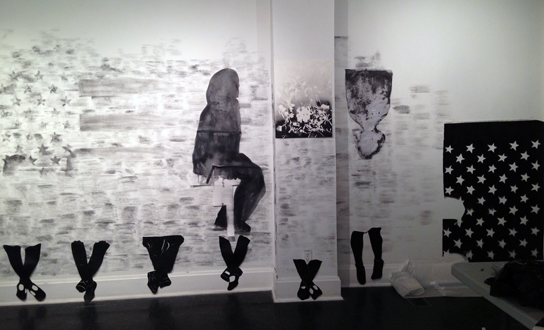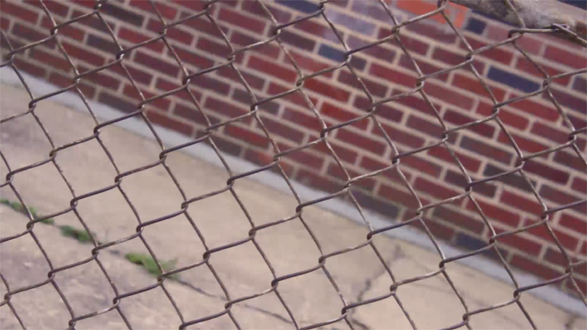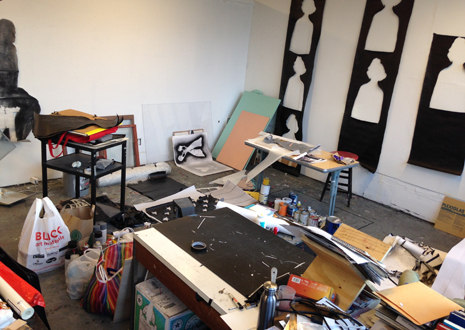by Sa’dia Rehman
ROY G BIV Gallery is currently exhibiting work by Nayeon Yang and Sa’dia Rehman. Yang’s live-feed videos and projections fill the gallery with ethereal iterations of its visitors. Rehman’s multidisciplinary installations discuss language and her upbringing in a Muslim-American household. The work of both artists will be on display May 6–27 at 997 N High St. Hours: 1– 6 pm Friday, Saturday and Sunday. Admission is free.
Below is an artist statement by Sa’dia Rehman in which she discusses the thought process behind her work.
The works included in my solo exhibition at ROY G BIV Gallery are:
- a wall drawing titled Erasure of Fallen Dust, 2017
- a drawing on paper titled Bul Bul ka Bacha, A Rhyme, 2016
- three 4 x 6 photographs titled A Family Garden, 2016
- and a video titled Ethnographer/Photographer, Episode 3: Corona/Queens, New York, 2017
The wall drawing and the video are supported by a grant from the Global Mobility Project at Ohio State University, an Arts & Humanities Discovery Theme Pilot Project
The wall drawing continued to evolve in the gallery and in my studio, rejecting the possibility of resolution and in support of the unfinished. My work addresses a void in contemporary visual art: the imagery of the Muslim family and its artifacts are essentially absent outside of depictions of war and violence abroad. Much of my work is rooted in narratives from my own experience and my family. For me the unfinished are these narratives and these thoughts, yet to be visible.
My work engages the unfinished as method, material, and process. By focusing on the unfinished, the work rejects the idea that any work is finished or fixed. Instead the work turns the viewer to focus on the process of art-making. It points to the subjectivity, rather than objectivity, of the artist as art-maker, and the viewer as consumer. Rather than suggest a stable truth, it suggests that we are all unfinished, changing, evolving. There is no complete, or possibility of complete, in the work: I am more interested in the relational and dynamic aspect of understanding and meaning making. The work deals with issues for which there are no answers. These issues exist in ever-shifting and polarized terrain–which makes understanding between the artist and the viewer near impossible.
My ongoing video series, Ethnographer/Photographer plays with concepts of language, power, belonging, and framing, as well as travel, tourism, voyeurism, and study. I use the word “ethnographer” in the title of this work knowing that this work is not a thorough study of human culture. However, the work uses elements of ethnography- observations, documentation, and records. I am the subject, the viewer, and the storyteller interacting with a city.
In earlier episodes of this work, I engaged with strangers and requested that they take photos of me. As I lend my camera to passersby, a non-verbal exchange of power occurred. The stranger became the photographer, positioned my body, directed my facial expressions, and composed the photograph. These simple gestures unfold into friendly conversations, revelatory stories, and momentary companionships. I then created a performance and video with the photographs and my accompanying journal entries. The interactions have lasted from five minutes to two days. However, I reveal just a few details of these interactions.
For the episode exhibited at ROY G BIV, I visited my childhood neighborhood of Corona and walked the streets for days. Many of the paths I walked traced the steps I ran around while a child growing up in Queens, New York. During my walk, I realized that this episode couldn’t follow the same formula as noted above. I felt that I needed to capture my walk by attaching my camera to my body. This episode is an unedited version of a twenty-minute walk from the 103rd street subway station to Masjid Al-Falah to what once was my dad’s halal meat shop now a barber shop, my childhood home, the firehouse across the street, the former Tiffany glass factory, P.S. 19Q, and the corner bodega.
997 N. High Street
Columbus, OH
Sa’dia Rehman copies, assembles, and disassembles family photographs, intimate and ritual objects, and visual and written language as a way to explore the limits and possibilities of self and collective being. Through collages, stencils, installations, and photo/video, she explores states of in-between, past and present, belonging and desire. She is currently exploring the role of walls in constructing interior and exterior spaces. Rehman has shared her work at Urban Art Space (2017), ROYGBIV (2017), Twelve Gates (2016), Center for Book Arts (2015), Local Projects (2014), Queens Museum (2012), Brooklyn Museum (2010), and Grey Noise (2008). She was selected for the Global Mobility grant (2017), Rasquache Residency in Puebla Mexico (2016), LMCC’s Artists Summer Institute (2011), AIM Bronx Museum (2008), and a residency at the National Gallery, Islamabad, Pakistan (2006). Her work has been featured inThe New York Times, Harper’s, Art Papers, and ColorLines. She will have a solo show at Pearl Conard Gallery, Mansfield, OH in January 2018. Rehman received her MFA from Ohio State University (2017) and her MA in Art History at City College, CUNY (2006).






